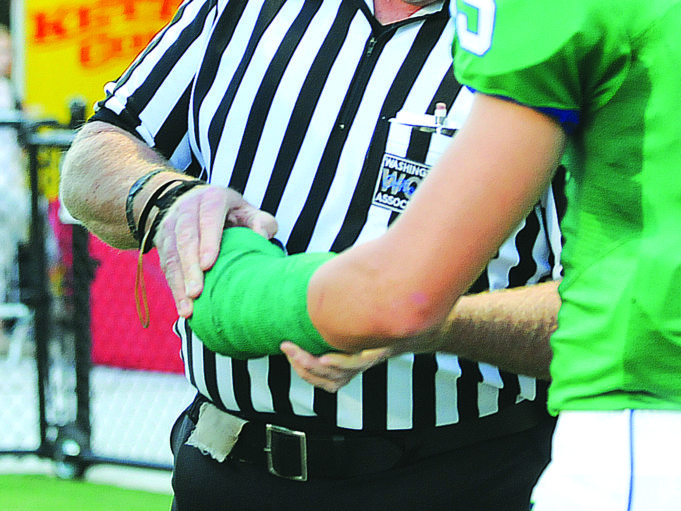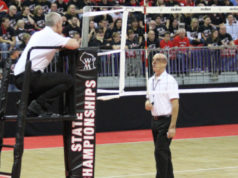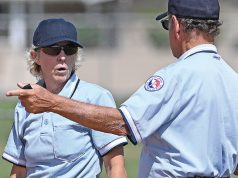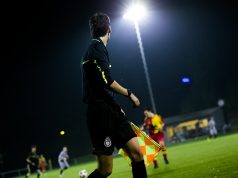One of the hazards of being a sports official is that you quickly become an expert consultant to your friends when they have a question about a rule or play, even if it doesn’t involve a sport you officiate. If you are also a lawyer, it can be even worse!
A number of years ago I was at a high school fundraiser when I heard, “Hey, Pat, you’re a referee, aren’t you?” I said yes, but added that they were talking about soccer and I have only officiated basketball. No matter to them though, because for officiating “civilians,” one referee is as good as another. “Besides,” they said, “you’re a lawyer.”
Turns out the discussion was an interesting one that really went beyond a specific sport. One of them had a daughter who was a star striker as a junior and getting her share of D-I recruiting love. Her team had just played in the state finals and won, in spite of the fact that she fractured her arm during the game. It was the circumstance surrounding that fracture that led them to invite me into the conversation.
They explained that the final, as you might expect, was a much anticipated match between two powerhouse girls’ soccer programs. One of the kids from the other team had a cast on her arm. In the course of the game, that girl swung her arm and struck the star striker. The move wasn’t intentional or even a foul.
Apparently there was some covering on the cast although it wasn’t clear exactly how much and what kind. There was a picture of the player with the cast and it certainly didn’t look like she had any foam or other padding or cushion on it. In any event, the covering wasn’t enough to stop the cast from breaking an opponent’s arm.
At the time, the striker was in quite a bit of pain, but didn’t know the arm was broken and was able to finish the game, although her efforts to guard her injured arm severely limited her effectiveness. The fact that her team won anyway dulled the pain for a while after the game, but she eventually ended up at an orthopedist. He diagnosed the broken arm and explained that she was going to be out of soccer for a while. That was very bad news because although the high school season may have been over, she would miss the upcoming club season, during which she had hoped to showcase her talents.
So, the group’s questions for me were pretty obvious — as an official, did I think the girl with the cast should have been allowed to play? And if not, as a lawyer, who did I think would be liable for the injured girl’s medical bills, pain and lost scholarship opportunities?
I first cautioned them that while I knew the rule about wearing a cast for basketball, I didn’t know if soccer had the same rule. (All NFHS sports have the same basic rule — casts must be covered with 1/2 inch of slow recovery foam.) I then said soccer referees have the same responsibility to make sure no player is allowed to play with equipment that unreasonably endangers another. The group also complained that they didn’t see the referee in the title game do the same equipment check usually done by other referees.
I responded that chances were very good that the referee chosen by the state to work the final was considered to be one of the best and it was very unlikely that he did not know the rules. I also conceded that it was possible that because of the high level and high stakes of the match, the referee didn’t want to start off by excluding one of a team’s better players, preferring to trust that the coach would not send a player out with an inadequately cushioned cast. We all have seen officials shrink from the tough call in crunch time under the guise of not wanting to take the game away from the players.
I didn’t know if that was the case in that game, but based just on what I could see from the picture and the descriptions of folks who were there, it seemed like it might have been. If so, the coach would be the first offender for wanting to win so badly she was willing to break the rules and jeopardize the kids playing the game. If the official didn’t check because he didn’t want to alienate half of the crowd and wreck the match even before it started, he was turning a blind eye to the rules. More importantly, he would have abandoned his responsibility to the girl that got hurt and could have cost her a chance to earn a college scholarship.
For all the talking we do about liability of officials, it’s pretty rare to have a case where one ends up at significant legal risk. But if an official fails to enforce equipment rules and a player gets hurt as result, the official could be on the wrong side of a lawsuit. Of course, the folks at the fundraiser were not totally unbiased witnesses, but if what they said was true, the official in that game could have easily found his name on a complaint next to that of the parents of the player with the cast, her coach and the state high school athletic association.
The fact that the official was probably one of the best and knew the rules almost makes it worse. Of course, the outcome might be the same, but it’s harder to fault someone who didn’t know how to do the right thing than someone who knew but wouldn’t. A state final, for most of us, is a relatively “big stage.” I suspect the same can be said for almost anyone with a whistle, whether it’s their first NCAA tournament game, a NFL playoff game or a FIFA qualifier. We don’t want to get out of our comfort zone and have to confront a coach who runs a big-time program and has gotten to that game. But if it’s necessary, that’s exactly what we’re paid to do. Whether it’s a rec league championship, junior high tournament final or even a BCS Bowl game, big-time stages demand bigtime officials who don’t shrink from the moment.
What's Your Call? Leave a Comment:
Note: This article is archival in nature. Rules, interpretations, mechanics, philosophies and other information may or may not be correct for the current year.
This article is the copyright of ©Referee Enterprises, Inc., and may not be republished in whole or in part online, in print or in any capacity without expressed written permission from Referee. The article is made available for educational use by individuals.


















